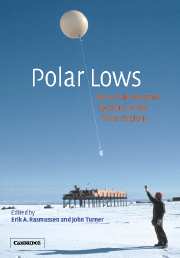7 - Conclusions and future research needs
Published online by Cambridge University Press: 07 December 2009
Summary
It will have become clear from the preceding chapters that major advances have been made over the last few decades in our understanding of the distribution, occurrence, formation and development mechanisms of polar lows and other high latitude mesoscale vortices. In this final chapter we summarize our present understanding of this family of weather systems and consider the requirements for future research.
The spatial distribution of polar lows and other high latitude mesoscale vortices
Polar lows were first investigated over the Nordic Seas and when systematic research started into such systems in the 1960s the case studies were concerned with lows occurring in this region. Subsequently, such investigations were gradually extended to new areas in the Northern Hemisphere, such as the Labrador Sea, the Gulf of Alaska and the Sea of Japan, where similar active mesoscale vortices were identified. Since the 1970s isolated cases have also been reported of polar lows over the marginal seas around the Arctic Ocean, including the Beaufort Sea, the Chukchi Sea and the Kara Sea. However, it is now unlikely that significant numbers of active systems will be found in any new areas in the Northern Hemisphere.
In the Southern Hemisphere, polar lows have only been thoroughly investigated in a limited number of regions. The lows found around New Zealand seem to have many of the characteristics of the systems occurring in the Nordic Seas, but much more work needs to be done on the polar lows in this area.
Information
- Type
- Chapter
- Information
- Polar LowsMesoscale Weather Systems in the Polar Regions, pp. 575 - 579Publisher: Cambridge University PressPrint publication year: 2003
Accessibility standard: Unknown
Why this information is here
This section outlines the accessibility features of this content - including support for screen readers, full keyboard navigation and high-contrast display options. This may not be relevant for you.Accessibility Information
- 1
- Cited by
